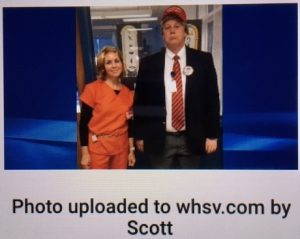You’re a writer—so for purposes of this blog, communicating without words means without dialogue. And there are many reasons you want to be able to do this. The presidential campaign offers several educational examples.
In Staunton, VA, for the Robert E. Lee High School Halloween, Principal Mark Rowicki dressed as presidential candidate Donald Trump, complete with Make America Great Again cap. Secretary Stephanie Corbett dressed as Hillary Clinton in “jail house orange” outfit, complete with a chain around her waist and a badge indicating she was inmate Clinton.
The costumes provoked a storm of comment, from those who claim they were just funny and timely costumes to those deeply offended and/or outraged. The latter say things like, “If they’d both dressed as presidential candidates, that would have been fine.” Or, “How dare they? Clinton has never been convicted of anything illegal!” Or, “How might the kids feel, seeing their principal dressed like a man who’s said he wants to deport them or their families?”
Lesson for writers: Having two or more characters absolutely committed to differing interpretations of the same event is an excellent way to build tension and conflict. And, BTW, consider what our clothing says about your character in general and in specific scenes.
If you look online for “candidate toilet paper,” you will find a myriad of choices. There are several options for Clinton and Trump, but also other 2016 presidential candidates: Presidents Obama and George W. Bush, and Mitt Romney, among others. The version that says “Dump with Trump” claims to be humorous and appropriate for both Democrats and Republicans. The one picturing Hillary and Bill Clinton together says, “Not Again!” so the intention is clearer. The seller who urges customers to choose the candidate they hate the most is the most direct of all.
Seeing just the TP: funny, disgusting, disrespectful, disdainful? More than one of the above?
Lesson for writers: Even if you think the meaning is absolutely clear, there’s always room for differing opinions. In your stories, you need to make the context clear, and/or state the interpretation(s) you want the reader to consider.
Just for practice: List as many inanimate objects as you can that you think convey a clear and unequivocal attitude/character of the owner. Then ask someone else to read the list and see whether you get disagreements.
A Kendall, FL homeowner hung two dummies from a tree in his front yard for Halloween. (See
Daily Mail for one complete article about this, or search online for Halloween effigies of hanged black men.) They are reminiscent of lynchings of real black people. Note the nearby sign supporting Trump for President. The fallout was immediate and widespread. The presumption was that the man who hung the dummies is publicly supporting Trump. Subsequently, a neighbor said the sign was hers.
Lesson for writers: When two things occur in close proximity in time and/or space, they often lead people to assume they are related. This is an especially effective device for mystery writers who want to introduce red herrings and/or lead the sleuth to solve the crime.
TAKEAWAY FOR WRITERS: When it comes to plot devices, the presidential campaign is clearly the gift that keeps on giving!
For future consideration: The Loud Voice of Body Language!







